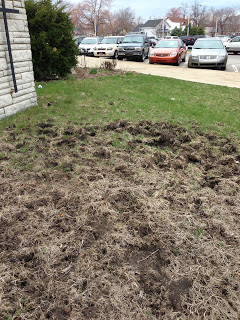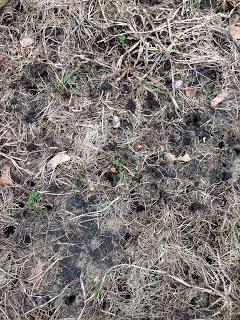The photos below were submitted to our laboratory for identification. While there are no animals present in the photos, the damage depicts the problem very nicely.
Even without seeing any, I am quite certain that the turf is infested with white grubs.
As you know, white grubs do some damage to grasses, but what damage they cause is sometimes more than compounded by other animals coming in to forage for the grubs.
Such is the case with this incident. It is clear that either raccoons, skunks or opossums have been digging for grubs in this area. The turfgrass ripped up and strewn all around (Photo #1) is evidence of foraging by these animals.
The second photo of ‘peck holes’ is similar evidence of grub foraging but in this case it is caused by birds. Apparently, they also are enjoying the grub buffet.
Together, these photos show the result of what may have been somewhat tolerable grub injury to a lawn, made intolerable by animal foraging on the grubs.
Since the grass is pretty much dead at this point, the only solution is to rake it up and replant or lay sod. Laying sod gives a quick fix to the problem, but not all animal foraging damage is this severe. Keep in mind that any grass that is not torn up will survive and thus give a head-start to an over-seeding strategy.
Consider applying grub control treatments during late July or August to prevent grubs from re-occurring next year.
Bird peck-holes
Tim Gibb
Insect Diagnostician

